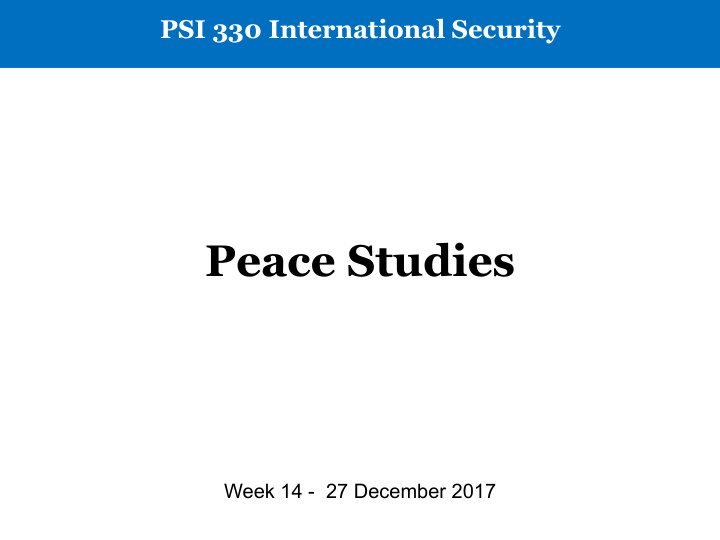



PSI 330 International Security Peace Studies Week 14 - 27 December 2017
The Basics • Central concern: the reduction and eventual eradication of war and the control and resolution of violent conflict by peaceful means • Other key focus: the definition of peace itself • The interdisciplinary origins / Normative stance. • Peace studies does not aim to eliminate all conflict. • Violence that is key • In the case of IR, for example, peace was treated in an unscientific and value- laden way, largely ‘for ritualistic and expressive purposes’ and not with the intent of clarifying or realizing a clearly defined end state. • For Galtung, orthodox IR scholarship relied too heavily on dictums – such as ‘if you want peace prepare for war’ – which had acquired the status of apodictic truth.
Violence Cultural Violence Visible Direct Violence Structural Violence Invisible
Definitions • Violence: “avoidable insults to basic human needs, and more generally to life, lowering the real level of needs satisfaction below what is potentially possible. Threats of violence are also violence.” (Galtung 1990) • Structural Violence: “the violence is built into the structure and shows up as unequal power and consequently as unequal life chances” (Galtung 1969: 171) • Cultural Violence: “those aspects of culture, the symbolic sphere of our existence … that can be used to justify or legitimize direct or structural violence” (Galtung 1990) • “Direct violence is an event, structural violence is a process with ups and downs and cultural violence is an invariant, a ‘permanence’, remaining essentially the same for a long periods, given the slow transformation of basic culture.” (Galtung 1990)
A Typology of Violence
Definitions • Basic Needs: • Survival needs -> negation: death, mortality • Well-being needs -> negation: misery, morbidity • Identity, meaning needs -> negation: alienation • Freedom needs -> negation: repression • Topdogs get much more (here measured in needs currency) out of interaction in the structure than others, underdogs.
Types of Structural Violence • Exploitation A : The underdogs may in fact be so disadvantaged that they die (starve, waste away from diseases) • Exploitation B : underdogs may be left in permanent unwanted state of misery, usually including malnutrition and illness • Penetration : implanting the topdog inside the underdog so to speak, combined with segmentation. • Segmentation : giving the underdog only a very partial view of what goes on • Marginalization : keeping the underdogs on the outside, combined with fragmentation • Fragmentation : keeping the underdogs away from each other.
A Typology of Violence
Vicious Violence Cycle Cultural Violence Direct Violence Structural Violence
Peace • Two compatible definitions of peace: • Peace is the absence/reduction of violence of all kinds. • Peace is nonviolent and creative conflict transformation. • For both definitions the following holds: • Peace work is work to reduce violence by peaceful means. • Peace studies is the study of the conditions of peace work. (Galtung 1996: 9)
Peace • Negative Peace: being the absence of war and actual physical violence • Positive Peace: initially described as ‘the integration of human society’ • “Thus, peace conceived this what is not only a matter of control and reduction of overt use of violence, but of what we have elsewhere referred to a vertical development.” (Galtung 1969)
Peace Research • Peace research, defined as research into the conditions – past, present and future – of realizing peace, will be equally intimately connected with conflict research and development research; the former often more relevant for negative peace and the latter more relevant for positive peace, but with highly important overlaps. (Galtung 1969) • Violence arises from the relations between sub-systemic groups, but humanity also displayed a capacity to cooperate and integrate.
Recommend
More recommend